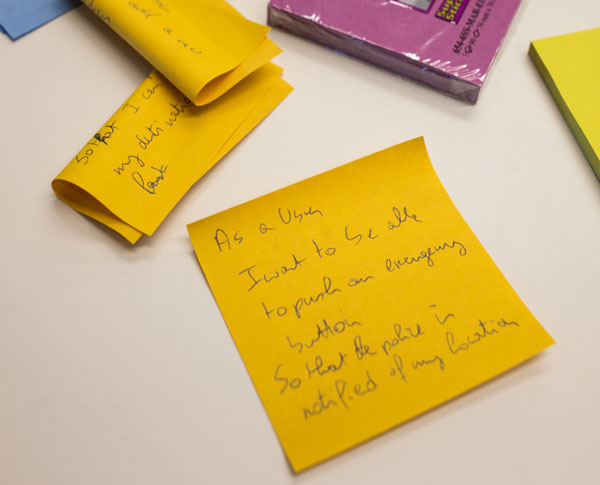Ok, so you’re about to start your first story mapping workshop with a fresh group of participants. You’ve prepared everything down to a T: from slide deck and sticky notes to shiny sets of ballpoint pens on the tables.
But how will you fare once all of those currently empty chairs have been filled?
What did you just say… calibrate?
User stories are a way to capture the requirements of your to-be-designed service in ‘business speak’. They’re built using a fixed pattern:
As a (who)
I want to (what)
So that (why)
The ‘who’ refers to the types of users of your service, the ‘what’ to the various actions those users can take, and the ‘why’ is – indeed – the intended outcome or result.
User stories are extremely useful when you want to develop a service from your customer’s point of view. They’re even more useful when they haven’t been written by a business analyst, but co-created together with your customers, employees and other stakeholders. That’s what the story mapping workshop is all about: creating the best user stories possible.
The quality of user stories largely depends on how they’re calibrated. It’s possible to use stories on various levels, such as the business level and the application level.
By calibrating your user stories you ensure that the participants in your workshop write the stories at the level you want. If you skip this step, you’ll find yourself in trouble.
A user story mapping workshop is all about creating the best user stories possible.
Understood. But how does it work?
When all user stories are formulated with the desired level in mind, it’s much easier to build a good story map. For a first workshop, it’s best to stick to the business level or the task level. This is done by introducing application-agnostic thinking, i.e. by establishing a framework that is far removed from the organization’s existing application landscape.
That’s quite a challenge, because your participants often have extensive ideas about what the desired application should look like and what features it should have.
A classic example of a user story at too low a level is this:
As a cashier
I want to have all of the items that are out of stock appear in red on my screen
So that I can inform the customer that the item he wants is currently not available and has to be ordered
When sticking to the task level, you avoid focusing too much on a specific implementation. Later on, you can dive deeper into the user stories and develop them on a functional or an application level – via a workshop or not.
The above example can be brought to the right level (or calibrated) by rewriting it as follows:
As a cashier
I want to know which items are out of stock
So that I can inform the customer that it is currently not available and has to be ordered
See how we have refrained from limiting our service’s implementation options? Sure, the out-of-stock items may be shown in red on the cashier’s screen, but they may be indicated in a different way just as well. For example, they can be listed in a completely separate category or get a certain symbol as prefix.
Putting it into practice
A good way to make sure that your workshop participants are on the right track is to make them write a handful of dummy user stories. They’ll gain useful experience before they start writing user stories for their organization’s new service.
You can go about this by giving a few examples of user stories in which you’ve purposely made a few errors and ask your workshop attendees to correct them.
Afterwards, present a fictional situation far removed from their organization’s ecosystem and have the participants craft user stories about it. Calibrate where necessary and keep it up until everyone’s on the same wavelength.
Once that’s the case, you can start with the user stories that form the true heart of your workshop.

Let’s calibrate!
To extract the maximum amount of value from a story mapping workshop, make sure that all stories are written at the same level. Give your workshop participants sufficient time to practice the technique using a fictional example before they start working on the stories for their organization’s service design.
This post contains several tips for writing great user stories at business level.

.png)


